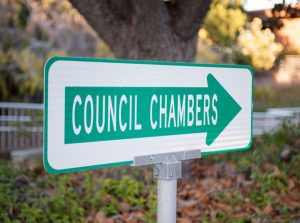By filing suit against Santa Clara Plays Fair’s (SCPF) petition for a referendum on the 49ers stadium agreements, Santa Clara jumped into California’s muddy waters of what’s legislation and what’s administration.
“The [California] courts have never held that every action following a legislative act is administrative,” says attorney Matthew Zinn of Shute, Mihaly & Weinberger (SMW), the San Francisco law firm representing SCPF.
Known for its experience in environmental and land use law, the firm also advises public agencies on land use and development planning. SMW has advised San Francisco on legal and environmental matters concerning the Hunters Point/Candlestick Point redevelopment project – a location once proposed for a San Francisco football stadium.
Zinn cites citing two cases in particular – Yost v. Thomas and Arnel Development v. Costa Mesa – noting that, unlike the cases cited by the 49ers Stadium LLC in its complaint, both cases were California Supreme Court decisions finding that local government actions based on previous legislation were, nonetheless, “legislative” and subject to referendum.
“This happens all the time in our system of government,” says Zinn, offering the examples of the EPA and FDA, which routinely write regulations based on legislation passed by Congress.
Yost v. Thomas: Municipal Actions Based on California Coastal Act Ruled Legislative
In Yost v. Thomas, after the Santa Barbara City Council approved a development project for a conference center and hotel, a citizens’ group filed a referendum petition to reverse the council’s action and sued. A lower court finding that City’s actions were administrative under the California Coastal Act (and thus not subject to referendum) was reversed by the California Supreme Court.
“The Coastal Act does not provide blanket immunity from the voters’ referendum power,” the court wrote in 1984. “Absent the Coastal Act the actions taken by the city council are clearly legislative. The adoption of a general plan is a legislative act…The amendment of a legislative act is itself a legislative act…and the amendment of a general plan is thus a legislative act subject to referendum.”
However, there’s one difference between this case and the current Santa Clara case. The Coastal Act was state legislation. As such, the state left “wide discretion to a local government not only to determine the contents of its land use plans, but to choose how to implement these plans,” said the court. “No…tightly circumscribed duty is imposed on local governments by the Coastal Act. The act does not dictate that a local government must build a hotel and conference center…”
By comparison, the law that the Santa Clara Stadium Authority is claiming the city is enacting is highly specific about building a stadium – Santa Clara Measure J, which is written into the city code Section17.20). So the court may not be persuaded that Santa Clarans were denied a vote on this specific land use.
Arnel v. Costa Mesa: Ballot Initiative on Zoning Changes Upheld
This 1980 case concerns land that was designated low and medium density residential by Costa Mesa’s general plan. However, the City subsequently rezoned the tract as planned development, low and medium density, and approved a project for about 120 single-family residences and 500 moderate-income apartments.
In response, the North Costa Mesa Homeowner’s Association circulated an initiative petition to rezone the tract to single-family residential, which passed by a narrow majority. One landowner took the city to court, and after two appeals the California Supreme Court ruled that zoning is legislative and can be enacted by initiative.
The court noted that “the initiative can be and is employed to support or oppose major projects which affect hundreds or thousands of persons and often present questions of policy concerning the quality of life and the future development of the city; it is not likely to be employed in matters which affect only an individual landowner and raise no policy issues.”
Dissenting Justice Richards saw things differently; in essence saying that zoning by ballot initiative was tantamount to using an axe where a scalpel was appropriate.
“The kind of public debate on the merits of a proposed zoning measure afforded by the election process, including the limited opportunity for the submission of written arguments to the voters, cannot be equated with a dispassionate study, evaluation and report upon the proposal by a staff of planning experts…notice and hearing before the planning commission…written recommendation by the planning commission with reasons for its recommendation… and notice and hearing before the legislative body,” Richards wrote.
“Moreover, the election offers the voters but a single choice, to accept or reject the proposal in its entirety. The legislative body, however, is empowered to modify (as well as approve or reject) a recommendation of the planning commission thereby enabling it to consider and take into account in its actions the legitimate claims and suggestions of those who would be affected by the proposal even though they may represent but a small segment of the electorate.”
Whether courts will see Santa Clara’s stadium financing plans as equivalent to zoning changes remains to be seen. But one thing is sure. This won’t be the last time Californians will argue about the difference between legislation and administration.
The Santa Clara suit is scheduled for a hearing on March 5, 2012 at 2:00 p.m. in Santa Clara Superior Court, Dept. 8, 191 N. 1st St., San Jose. You can follow case activity at www.sccaseinfo.org. The case number is 112CV217730. For more information about Yost v. Thomas or Arnel v. Costa Mesa, visit law.justia.com.











0 comments